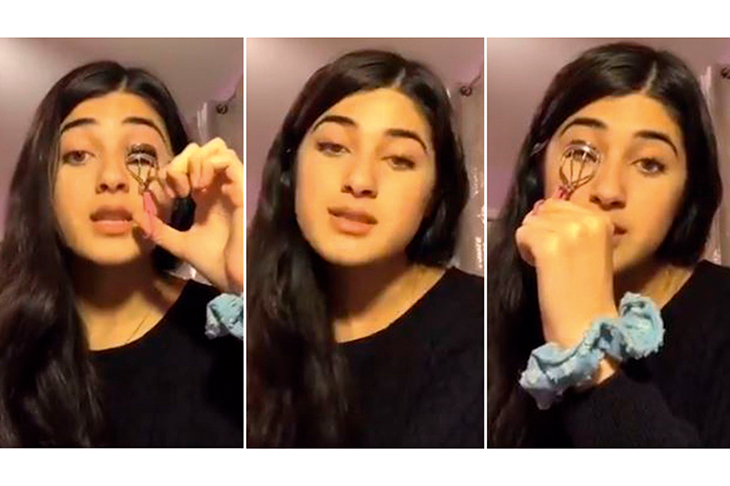In November last year, an internet video made by a 17-year-old American went viral. The video was less than a minute long and began with its creator, Feroza Aziz, looking directly into the camera and talking viewers through a makeup tutorial. ‘The first thing you need to do is grab your lash curler. Curl your lashes, obviously. Then you’re going to put them down and use your phone…to search up what’s happening in China, how they’re getting concentration camps, throwing innocent Muslims in there, separating families from each other, kidnapping them, murdering them, raping them, forcing them to eat pork, forcing them to drink, forcing them to convert.’
The words gush out not in fiery anger but in the slightly bored instructional tones of all makeup tutorials, while she continues to curl her lashes. To end, Aziz flashes a cutesy, knowing smile: ‘Please be aware. Please spread awareness and, yeah, so, you can grab your lash curler again…’ As subversive political messaging goes, it was a masterpiece. One of the first truly consequential videos to be made using TikTok, the world’s fastest-growing — and at its best most creative — digital platform.
Though it launched only two years ago, TikTok already has more users than Twitter and Snapchat combined. It hit that all-important one billion mark last year, while its rivals spent triple the time reaching the same figure. Its parent group, the Beijing-based ByteDance, is estimated to be worth $75 billion, the highest-valued tech startup to date. TikTok is also the first Chinese-owned platform to become the most downloaded app in America, and what its dominance might mean for the future of the internet, entertainment, music and society are questions that people are increasingly interested in and worried about.
Shortly after Aziz posted her video about the maltreatment of the Uighur Muslims, TikTok temporarily took down her account. They blamed this on a ‘human moderation error’ relating to another post. Many — including Aziz — weren’t buying this. TikTok’s dominance, until that point, had been achieved without the political controversies that have dogged platforms such as Facebook and Twitter. In fact, much of its content, generated by its predominantly teenage user-base, seemed decidedly apolitical and harmless — certainly when compared with the rest of the internet.
In September 2019, the New York Times set its art critics the task of reviewing TikTok and they immediately commented on the platform’s ‘goofiness’. The most popular videos captured a sense of novelty and innocence that had disappeared from platforms such as Instagram (which had become dominated by the glamorous lifestyles of ‘influencers’) and YouTube (which had been ravaged by Trump-esque culture wars). What thrived on TikTok were videos that were fun to make — and to watch.
At the time, the platform was driven largely by its video ‘challenges’ — viral events in which users won over fans by bringing their humor and creativity to a pre-agreed video format. These crazes were part ice-bucket challenge (the now-ancient viral Facebook stunt from 2014) and part Oulipo, the oddball literary collective who believed in uber-restrictive forms as a way of unleashing true creativity. The best ones were surreal and smart — such as the videos of girls dancing to their ex’s abusive voicemails — and soon spawned thousands of user-generated video responses from across the world. And with almost everything set to pop music, the whole thing seemed like a giant interactive music video.
TikTok launched a whole wave of young creatives, seeking to become ‘TikTok famous’. Unlike Instagram celebrities, though, there was no requirement to be photogenic and glamorous; instead the most successful TikTokkers were often the funniest and most creative ones. When I spent a week on TikTok, I was impressed by ‘sadmuslimgirl’ — a hijab-wearing teenager who used TikTok to make comedy videos about her life as an American Muslim. The target of the jokes varied. Sometimes they would attack media stereotypes of Muslims — a common topic for professional comics; at other times they were much more novel and original. Though the jokes were often about the difficulties of fitting in as a teenage Muslim, the videos were never angry or provocative, nor did they obsess over complicated notions of identity politics and political correctness. They were just — well, fun.
I was impressed, too, by how easy it was to make TikTok videos — something that removed the entry barriers for those who might otherwise find it difficult to make art. I spoke to Amy Hayward, a 25-year-old supermarket worker from Essex who’d had tens of millions of views for her comedy videos (many of which deal with her unglamorous day job). She told me she’d always been the funny one in her friendship circle but had never really applied her talents to anything creative before. But TikTok, which provides a free-to-use video-editing suite and hundreds of millions of potential viewers, had made it easy for people like her to produce these little films. The most money she had spent was on a small lighting rig to improve the quality of her videos — and even that came to less than £200 ($260). Now her videos were seen by millions of other TikTokkers.
But while TikTok’s popularity is driven by the creativity of users such as Amy, behind the scenes lies another of the app’s distinguishing features: its pioneering use of artificial intelligence to curate users’ viewing experiences. Compared with previous platforms, TikTok is ruthlessly efficient in gathering data on its users’ behavior and preferences and in using this information to direct them to videos that were most likely to entertain them. The end result is a lightning-quick scrolling experience, in which users move effortlessly from one 15-second video to the next, creating a convincing feel of creative anarchy. All the while, though, the experience is shaped by ByteDance’s algorithms, continuously using the data to refine and improve the computations. According to tech experts, the system is making billions of calculations every second to work out exactly what’s driving viewers’ attention.
With tens of millions of willing volunteers every day, TikTok might just be one of the most sophisticated artificial intelligence endeavors in the world. Given this technology was developed in China, where tech companies have been asked to hand over their data to the government, you can see why it’s caught the attention of US senators, some of whom have declared TikTok to be a ‘counterintelligence threat’, and even the Pentagon, which has banned American soldiers from using the app.
Take facial recognition technology: with most TikTok users starring in their own videos, ByteDance has probably acquired billions of images of users’ faces worldwide. Yet similar technology is routinely used for surveillance in China, including to keep tabs on Uighur Muslims. Elsewhere, corporates are developing software to predict who might be a shoplifter by monitoring how people move around a store. Could TikTok’s vast database on human poses — mined from hosting innocent dance challenges — be used to accelerate this technology?
When Jia Tolentino, a writer for the New Yorker, asked ByteDance how it would keep its data safe from the Chinese government, it pointed out that users’ data was always stored within their home country (reassuring, perhaps, for American TikTokkers, but not so much for the platform’s 400 million Chinese users). But a former Facebook developer told a different story. The only thing that mattered, he said, was the location of the platform’s coders and engineers: ‘Everyone else is a puppet paid to lie to you.’ And where were TikTok’s engineers based? Largely in Beijing and Shanghai.
The impact of TikTok’s algorithms are already being felt across the world — and in ways that are reshaping and redefining popular culture. The ubiquitous use of pop music in TikTok (with the same 15-second snippet often used from one video to the next) has already played havoc with the singles chart which, since 2014, has taken account of the amount of times a track is streamed online. When an unfashionable or obscure song becomes the soundtrack to a viral challenge, it can amass millions of streams in a day — making it appear more popular than it really is. Now pop producers have cottoned on and begun writing songs that are geared for TikTok success. One hit songwriter Kamille admitted to an obsession with TikTok in an interview with the Guardian recently, tailoring tunes to make them meme-friendly: ‘I think about [adding] weird production parts, because that tends to really work on TikTok.’
Like Facebook and Twitter before it, TikTok is slowly but surely molding society to its meme-generating ways and, under the cover of goofiness, honing AI tools that will have repercussions far beyond the charts.
TikTok’s inner workings remain highly secretive, meaning that — while it might avoid the blunt step of removing politically sensitive content or feeding information to authorities — it can easily tweak its algorithms to divert viewers away from certain videos, or distract them with something else entirely.
For TikTok’s billion-strong fanbase the platform has become a byword for freedom, creativity and fun. Many will have no understanding of the complex artificial intelligence that drives their viewing experience. By contrast, the platform is quickly understanding more and more about them. And that could have massive implications for all of us.
This article was originally published in The Spectator’s UK magazine. Subscribe to the US edition here.



















